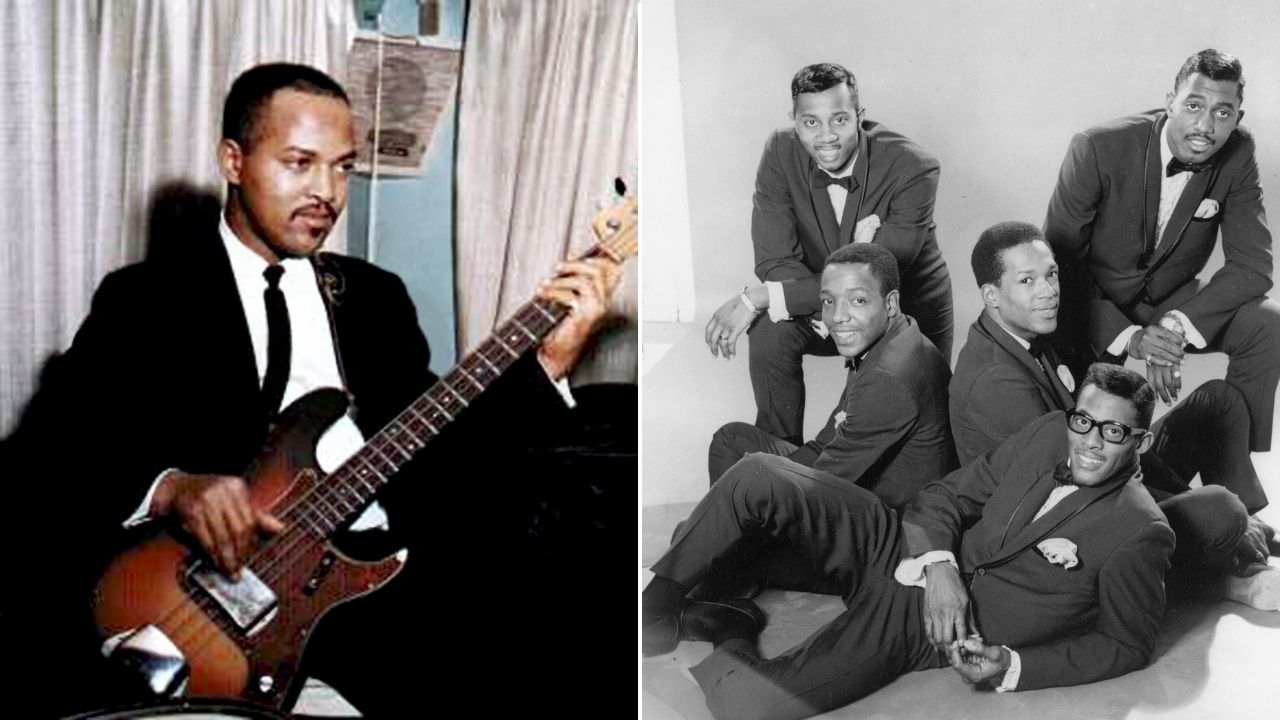How the Beatles crafted the guitar and bass tones that forever changed the sound of rock music
We chart the evolution of the Fab Four's sound through the key tracks and the gear that made them
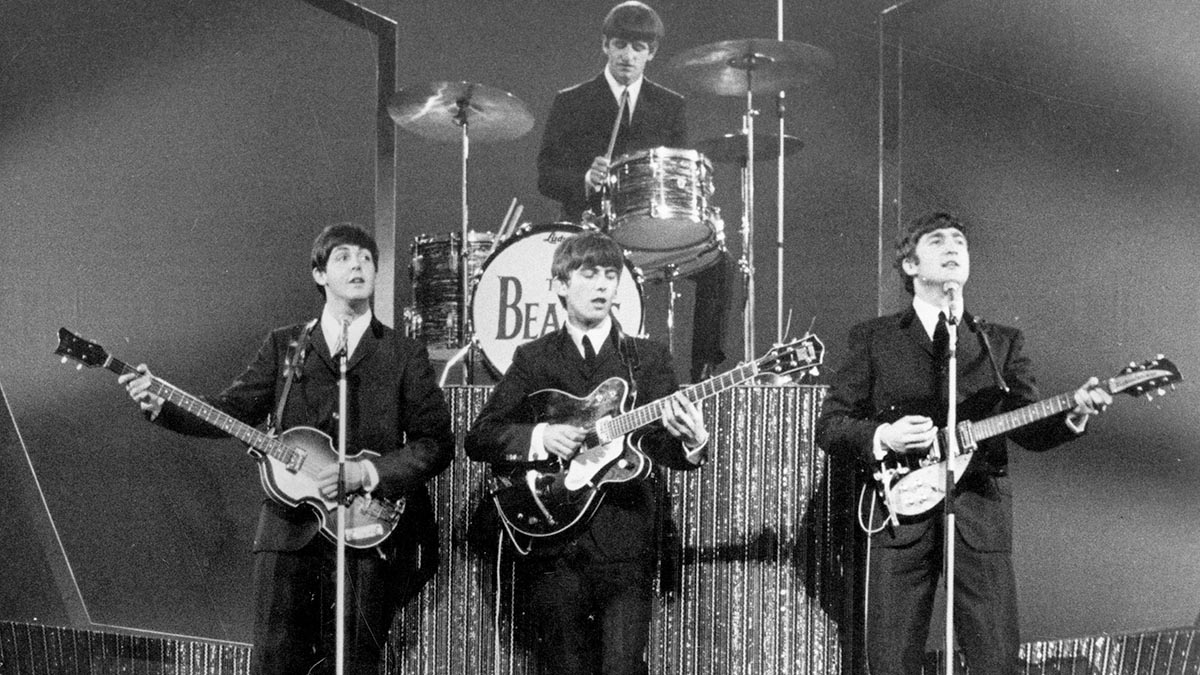
No band has had more pages written about them than the Beatles. There are books that examine every day of the band’s history, large volumes about their recordings and books devoted entirely to their gear. Yet for all that has been written about them, there is still much mystery about the finer details, such as what exact guitars and amps they used to record specific songs.
We set out to answer that last question by closely examining a select group of songs spanning the Beatles’ entire recording history. A big part of the challenge is that a great amount of conflicting info exists, even among the experts. Even the members of the Beatles, producer George Martin and engineers like Geoff Emerick have provided conflicting accounts, and sometimes those people have contradicted themselves.
Photos taken during the recording sessions provide helpful hints, but all too often crucial details are missing, and the best anyone can do is speculate. Internet forums are frankly a hell-hole of highly opinionated alpha characters who insist they have golden ears but are usually pulling utter BS out of their golden rears.
What follows is our best attempt to determine the guitars, basses, amps and effects that the Beatles actually used. This information is not perfect and in many cases is highly speculative (such as the amp that Lennon used to record his solo on The End). However, we hope it will provide a good guideline for guitarists who want to decode the magical mystery of the iconic sounds that the Beatles’ crafted over an incredibly prolific seven-year period.
Please Please Me – Please Please Me (UK), 1963
Guitar: 1957 Gretsch 6128 Duo Jet
Amp: 1962 Vox AC30 combo with two Celestion T530 12-inch speakers
All the latest guitar news, interviews, lessons, reviews, deals and more, direct to your inbox!
Guitar: 1958 Rickenbacker 325 Capri
Amp: 1962 Vox AC15 combo with two Goodmans 12-inch speakers
Bass: 1961 Hofner 500/1
Amp: Leak Point One preamp, Leak TL-12 Plus power amp, 1x15 cabinet with Tannoy Dual-Concert speaker
The Beatles’ debut single Love Me Do enjoyed only moderate success, but their follow-up, Please Please Me was the band’s first bonafide hit. Like most of the other material the Beatles recorded in the early Sixties using two-track recorders, the recording primarily captures the band performing live, with George Harrison’s Gretsch Duo Jet dominating the instrumental accompaniment.
The melodic hook features Harrison’s Gretsch and John Lennon’s overdubbed harmonica playing in unison. This technique of combining and layering instruments together was something the Beatles employed often throughout their career.
The guitar tones are very clean, with Harrison taking advantage of his Duo Jet’s low-end twang (picking near the bridge) while Lennon’s rhythm part is subdued and low in the mix. The Quad QCII bass amp Paul McCartney usually used for live performances at the time was not considered up to snuff for the recording, so he plugged into the studio’s Leak preamp and power amp instead.
Harrison and Lennon owned 1962 Vox 2x12 combo amps with fawn-colored covering, with Lennon playing though an AC15 and Harrison using an AC30 with an add-on treble boost circuit that became known as Top Boost on later Vox AC30 models, which Harrison used to brighten his guitar’s treble frequencies.
A Hard Day’s Night – A Hard Day’s Night, 1964
Harrison
Guitar: 1963 Rickenbacker 360/12 electric 12-string
Amp: 1963 Vox AC50 Mk I head and 2x12 cabinet with two Celestion T530 12-inch speakers and Goodmans Midax horn
Lennon
Guitars: 1963 Rickenbacker 325, 1962 Gibson J-160E acoustic electric guitar
Amp: 1963 Vox AC50 Mk I head and 2x12 cabinet with two Celestion T530 12-inch speakers and Goodmans Midax horn
McCartney
Bass: 1963 Hofner 500/1
Amp: 1963 Vox AC100 head and 2x15 cabinet with Celestion T900 15-inch speakers
The Beatles progressed to using four-track recorders in the studio early in 1964, which gave the band more freedom to experiment with overdubs and more advanced arrangements.
By mid April of 1964 when they recorded A Hard Day’s Night, Harrison and Lennon had expanded their guitar collections, which now included various Gretsch and Rickenbacker models – most importantly George’s newly acquired Rickenbacker 360/12 electric 12-string that played a crucial role in this song’s signature sound.
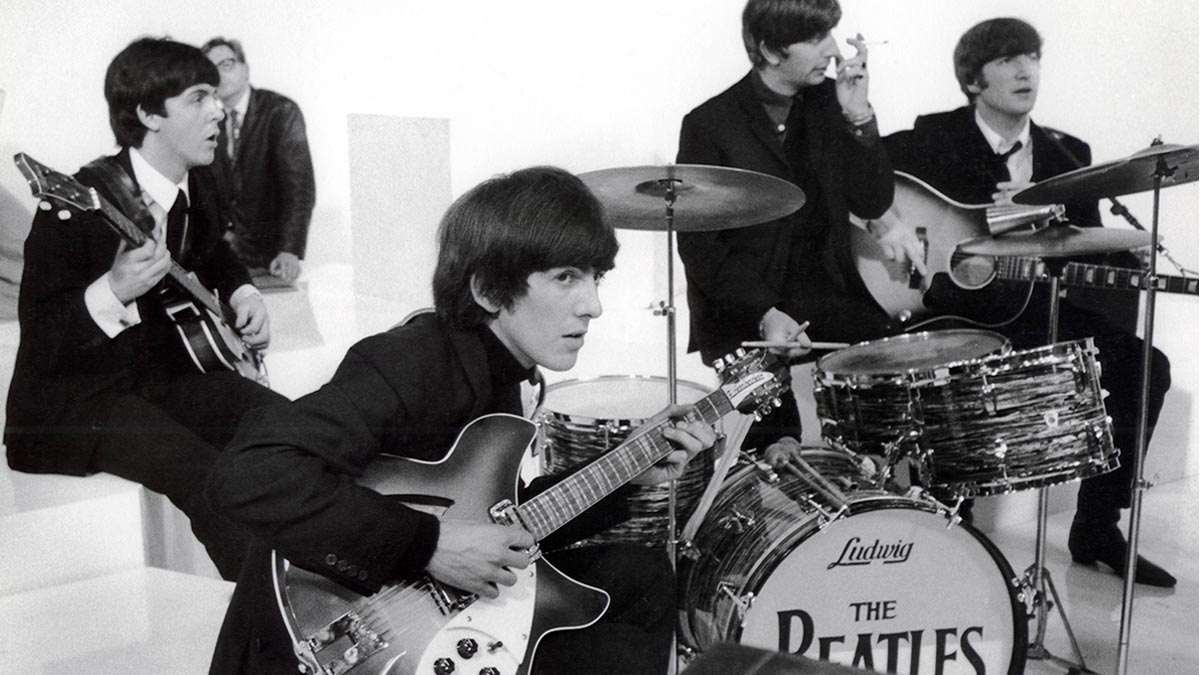
Musicologists can explain the intricacies of the song’s opening chord in better detail, but it was created by a blend of Harrison’s Rickenbacker 12-string, a D from McCartney’s bass and overdubs of Lennon’s Gibson J-160E acoustic-electric and a piano chord played by producer George Martin.
The main rhythm guitar parts were recorded as a simultaneous performance, with Harrison on the Rickenbacker 360/12 and Lennon on his new 1963 Rickenbacker 325, both playing through new Vox AC50 Mk I heads with 2x12 cabinets that delivered ample clean headroom for the strings to sing with clarity and twang.
The amps were probably set with the Treble controls near full, the Bass rolled down around 2 or 3 and the Volume no higher than 5 to avoid upsetting the lab coat-wearing engineers at Abbey Road.
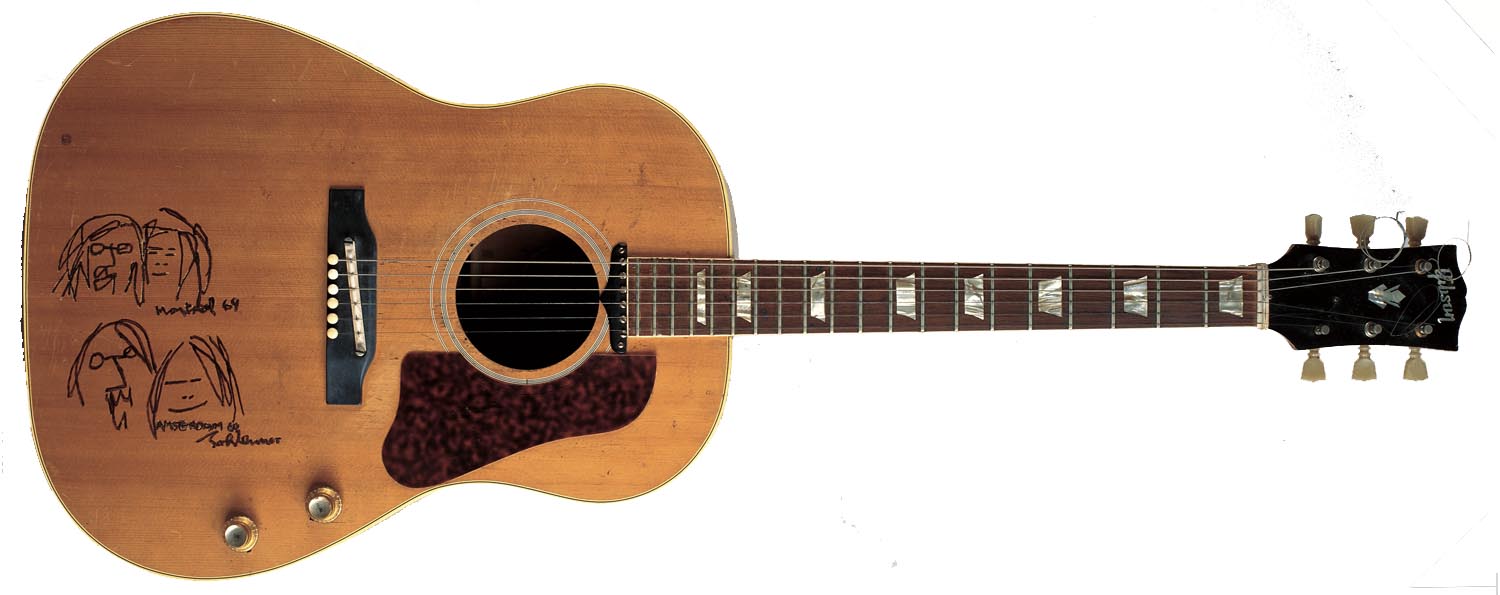
Harrison’s overdubbed solo employed a crafty studio trick devised by Martin. The solo was recorded at half speed, which made it easier for Harrison to play the notes on his 360/12, and Martin played a piano in unison at the same time.
Played back at normal speed, the pitch is transposed up an octave, giving the guitar a distinctive timbre. Guitarists hoping to duplicate this sound live can use a pitch shifter set to an octave up effect, like an Eventide Pitch Factor, Boss PS-5 Super Shifter or DigiTech Whammy (avoid Octavia or octave fuzz pedals, which sound too distorted).
I Feel Fine – Beatles ’65 (USA), 1964
Harrison
Guitar: 1963 Gretsch 6119
Tennessean
Amp: 1964 Vox AC100 head with 4x12 cabinet with four Celestion T1088 12-inch speakers and two Goodmans Midax horns
Lennon
Guitar: 1964 Gibson J-160E
Amp: 1964 Vox AC100 head with 4x12 cabinet with four Celestion T1088 12-inch speakers and two Goodmans Midax horns
McCartney
Bass: 1963 Hofner 500/1
Amp: 1964 Vox AC100 head with 2x15 cabinet with Celestion T1074 15-inch speakers
his recording is notable for featuring possibly the very first instance of intentional feedback, which was the effect of Lennon’s amplified Gibson J-160E becoming driven by the resonance of a low A note played on the bass by McCartney during the intro.
Instead of the usual high-pitched howl, the J-160E’s resonant chamber caused its sympathetic open A string to vibrate – similar to the effect of an E Bow – so vigorously that it buzzed against the fretboard.
Lennon’s amplified J-160E provided that backbone for the guitar riff heard throughout the song, which has an unusual organ-like timbre. Unlike a modern acoustic-electric, the J-160E was designed with a heavier top and stiff ladder bracing to suppress vibration. Ironically, this was Gibson’s attempt to avoid feedback, but the model’s most famous use is to generate feedback.
A P90 single-coil identical to those found on early Les Paul models was mounted under the top at the edge of the fretboard, with the polepieces extending through the top and covered with a small plastic housing. The P90 works better with standard nickel electric strings. Lennon probably used flatwound Pyramid Gold strings (most likely .012-.052), which also contributed to the smoother-sounding timbre.
Harrison’s part mostly consisted of him doubling Lennon’s riff on his Gretsch Tennessean, most likely set to the bridge pickup as heard in his brief twangy solo.
Ticket to Ride – Help!, 1965
Harrison
Guitars: 1963 Rickenbacker360/12 (rhythm), 1961 Fender Stratocaster (overdub fills)
Amp: 1964 Vox AC100 head with 4x12 cabinet with four Celestion T1088 12-inch speakers and two Goodmans Midax horns
Lennon
Guitar: 1961 Fender Stratocaster
Amp: 1964 Vox AC100 head with 4x12 cabinet with four Celestion T1088 12-inch speakers and two Goodmans Midax horns
McCartney
Guitar: 1962 Epiphone Casino E-230TD (lead)
Amp: 1964 Vox AC100 head with 4x12 cabinet with four Celestion T1088 12-inch speakers and two Goodmans Midax horns
Bass: 1963 Hofner 500/1
Amp: 1964 Vox AC100 head 2x15 cabinet with Celestion T1074 15-inch speakers
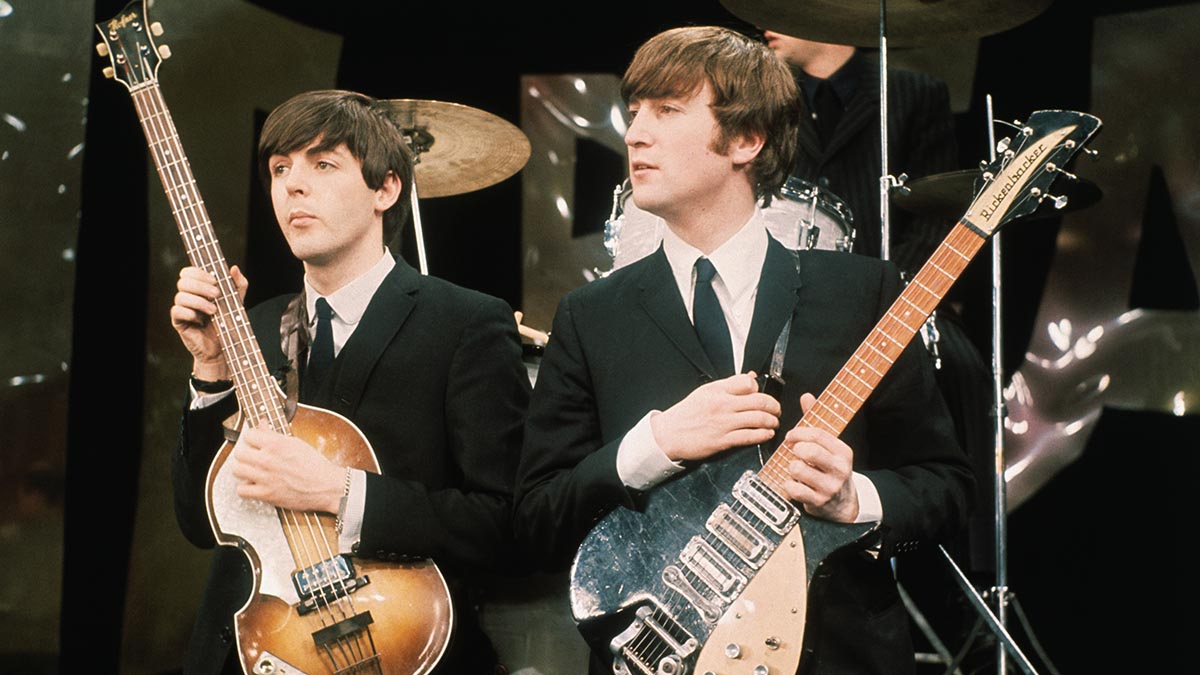
The topic of who actually played what parts and what exact guitars on the Beatles recordings is subject to much speculation, but “Ticket to Ride” is one exception where this info can be confirmed, thanks to George Martin’s detailed track notes about the instruments and players.
Martin’s handwritten notes specify that Harrison played his Ric 360/12 accompanied by Lennon on a 1961 Fender Stratocaster on the rhythm part and McCartney laid down the fills and outro on his 1962 Epiphone Casino.
On track four, Harrison also overdubbed a few accents, like the descending pattern on the second “ride” of the chorus, using a ’61 Strat while McCartney recorded his lead fills on the same track. The Help! sessions were notable for featuring McCartney’s first contributions beyond bass as a guitarist, a role which he would expand even more on later recordings.
As in previous instances, the Vox AC100 guitar amps are dialed to crystalline clean tones with the Treble above five and the Bass barely up. McCartney probably plugged his Epiphone Casino into Lennon’s amp and used either the middle or neck pickup setting with the guitar’s tone knobs backed down a bit.
Although Harrison’s Ric 12-string had defined much of the early Beatles’ signature sound up until this point, Ticket to Ride was one of the last instances where he used it in the studio. “All it ever seemed was that there was one sound I could get (from the Rickenbacker) where it was bright,” Harrison told the BBC in 1987. “(That’s) the sound you hear on Ticket to Ride.” Soon, his Gretsch and Rickenbacker guitars became distant memories as his taste in guitar tones progressed.
Michelle – Rubber Soul, 1965
Harrison
Guitar: c. 1963-65 Gibson ES-345 (solo), Framus Hootenanny 12-string (Rhythm)
Amp: 1963 Vox AC30 Top Boost combo with two Celestion T530 12-inch speakers
Lennon
Guitar: Ramirez 1A classical
McCartney
Guitar: 1964 Epiphone Texan FT-79
Bass: 1964 Rickenbacker 4001S
Amp: 1964 Fender Bassman (blonde) 6G6-B head, 2x12 cabinet with Jensen C12N, Oxford 12M6 or possibly Utah speakers
A photo shot at Abbey Road Studios during a pre-recording rehearsal of this song gives a very good idea of the exact guitars used by Harrison, Lennon and McCartney for the recording of the main acoustic rhythm track: a Framus Hootenanny 12-string (Harrison), Ramirez 1A nylon string classical (Lennon) and Epiphone Texan FT-79 (McCartney).
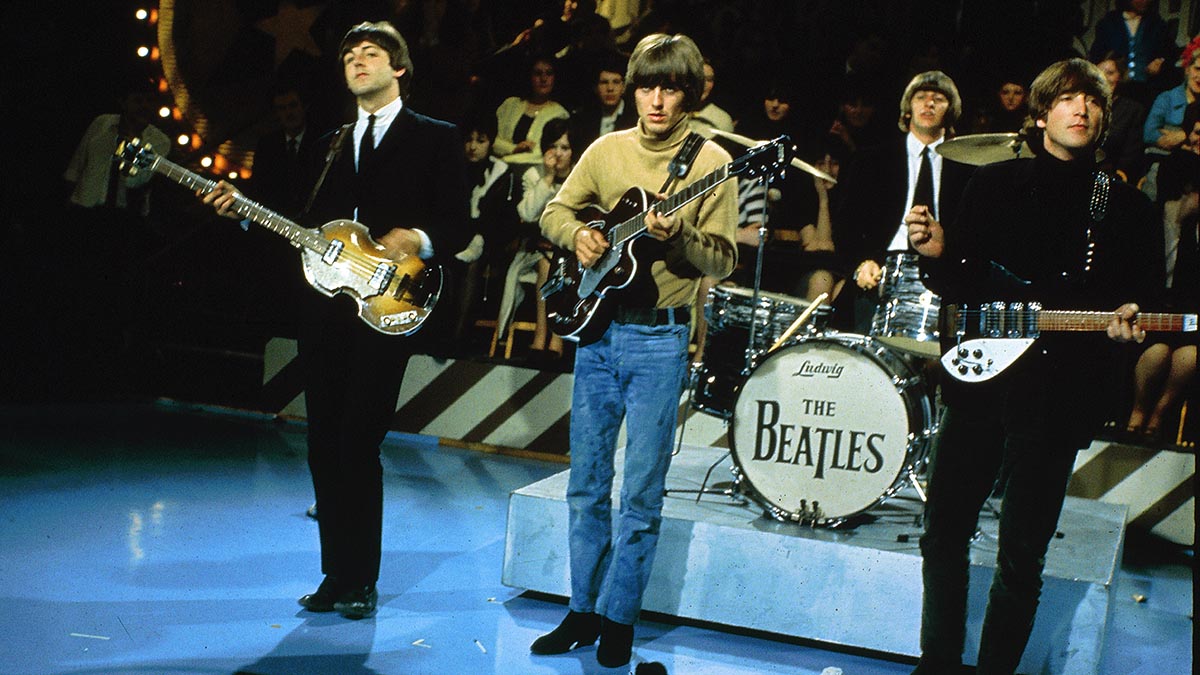
One particularly revealing detail is that all three guitarists used capos on the fifth frets of their guitars. Also of interest is a later photo showing McCartney playing his Rickenbacker 4001S bass also with a capo on the fifth fret. Harrison’s 12-string is very low in the mix, heard most prominently on the descending line in unison with McCartney and Lennon’s louder six-strings.
The big unsolved mystery is which guitar Harrison used for the sultry, horn-like solo heard in the middle and ending of the song. “The guitar solo in ‘Michelle’ is my composition, actually,” producer George Martin revealed in a 1993 interview. “I wrote down the notes and said, ‘I’ll play this. George, you can do these notes with me on guitar. We’ll play in unison.’”
Harrison’s guitar tone is very warm, muted and unusual compared to other Beatles recording, which suggests he may have used a Gibson ES-345 semi-hollow
Apparently, Martin’s unison part was discarded. Harrison’s guitar tone is very warm, muted and unusual compared to other Beatles recording, which suggests he may have used a Gibson ES-345 semi-hollow, which briefly showed up in his possession around the date of these sessions.
Other speculated candidates include his Gibson J-160E, Epiphone Casino and even the 1961 Strat using the neck pickup and tone control rolled off. The jazz hollowbody-like warmth and humbucker-like fatness, however, strongly suggest he used the 345’s neck pickup, rolled down the tone control and played with his fingers. The amp he used is also unknown, although session photos show that Harrison and Lennon had dusted off their trusty black 1963 Vox AC30s.
Taxman – Revolver, 1966
Harrison
Guitar: 1964 Gibson SG
Standard
Amp: 1966 Vox 7120, 4x12 cabinet with Celestion T1225 12-inch speakers
McCartney
Guitar: 1962 Epiphone Casino E-230TD
Amp: 1964 Fender Bassman (blonde) 6G6-B head, 2x12 cabinet with Jensen C12N, Oxford 12M6 or possibly Utah) speakers
Effect: 1966 Sola Sound Tone Bender (Mk 1.5)
Bass: 1964 Rickenbacker 4001S
Bass amp: 1964 Fender Bassman (blonde) 6G6-B head, 2x12 cabinet with Jensen C12N, Oxford 12M6 or possibly Utah) speakers
Many guitarists consider this one of their top 10 favorite Beatles tunes, thanks to the biting guitar tones, Harrison’s cutting 7th chords and McCartney’s gritty raga-style solo and punchy bass riff. For some unknown reason, Lennon sat this one out when it came to playing a guitar track and his only contribution is backing vocals. To fill the sonic space, Harrison double-tracked his rhythm guitar part by playing two identical takes.
The solo is one of the main sources of guitarists’ fascination with this song. McCartney confirmed that he played his 1962 Epiphone Casino (probably set to the bridge pickup), and photos taken in the studio around this time strongly suggest he plugged into his trusty Fender Bassman head and 2x12 cabinet.
A Sola Sound Tone Bender Mk 1.5 (set with Level just above 5 and Attack at 6 to 7) also seen in photos likely provides the distortion heard on the solo, riff unisons and fills.
Details about Harrison’s rig are more sketchy. To me it sounds like he’s playing his Gibson SG Standard (bridge pickup) through one of the new hybrid (solid-state preamp/tube power amp) Vox 7120 amps the band acquired thanks to the fast, percussive attack, scratchy treble and nasal midrange.
Other options include his 1961 Strat and a new 1966 Fender Showman stack that appeared around this time, but blackface tube Fender amps generally sound more polished and sparkling than what is heard here.
McCartney’s bass tone is impressively punchy and robust. He probably plugged his Ric 4001S into the same Bassman rig that he used to record his guitar part to give the tone more presence.
Sgt. Pepper’s Lonely Hearts Club Band – Sgt. Pepper’s Lonely Hearts Club Band, 1967
Harrison
Guitar: 1964 Gibson SG
Standard
Amp: 1967 Vox UL730 head, 2x12 cabinet with two Celestion T1088 12-inch speakers
McCartney
Guitar: 1962 Epiphone Casino E-230TD
Amp: 1967 Vox UL730 head, 2x12 cabinet with two Celestion T1088 12-inch speakers
Bass: Rickenbacker 4001S
Amp: DI (direct)
Thanks to the agreement that manager Brian Epstein arranged and maintained with Vox, the Beatles enjoyed a constant influx of the newest Vox amp models in the studio up through Epstein’s death in August of 1967. In February 1967 when the Beatles started work on the Sgt. Pepper’s album, the band took delivery of several Vox UL730 hybrid solid state/tube amps, which they immediately put to use.
For the album’s title song, Harrison and McCartney first recorded their rhythm guitar parts together, each using separate UL730 amps dialed in to tones with just a hint of overdrive.
Later in early March, McCartney recorded an additional lead track using the UL730’s built-in fuzz effect, which was accessed via an on/off footswitch (with no controls for gain or intensity, just fuzz on or off). The early rhythm guitar track was panned to the center (it can be isolated by adjusting balance to the left) while McCartney’s fuzz lead guitar overdub is panned to the right along with his lead vocals.
McCartney is seen in a photo taken on March 3, 1967, during the overdub session playing a Fender Esquire plugged into a Selmer Thunderbird 50 Mk II combo amp, with his Epiphone Casino resting at an angle on the amp. It’s widely assumed that Paul used this rig to record Sgt. Pepper’s, but a more likely scenario is that he used it for the bright, jangly rhythm guitar part heard on With a Little Help from My Friends also recorded that day as no fuzz pedal (which is essential for his lead track) is in sight.
Although bass amps are still seen in Beatles studio photos from this point onwards, McCartney was recording most of his bass tracks using a DI box instead of miking an amp. The bass amp was just there so his bandmates could hear his bass parts while they were recording.
Revolution – B-side of Hey Jude single, 1968
Harrison
Guitar: 1964 Gibson SG
Amp: Redd.47 line amplifier
Lennon
Guitar: 1965 Epiphone Casino E-230TD
Amp: Redd.47 line amplifier
McCartney
Bass: 1964 Rickenbacker4001S
Amp: DI
About a year and a half after Paul McCartney started recording his bass direct in the studio, Lennon and Harrison first adopted this approach as well when recording Revolution. The motivation for this was driven by Lennon’s demand for the most violent and extreme distortion tones on guitars as possible.
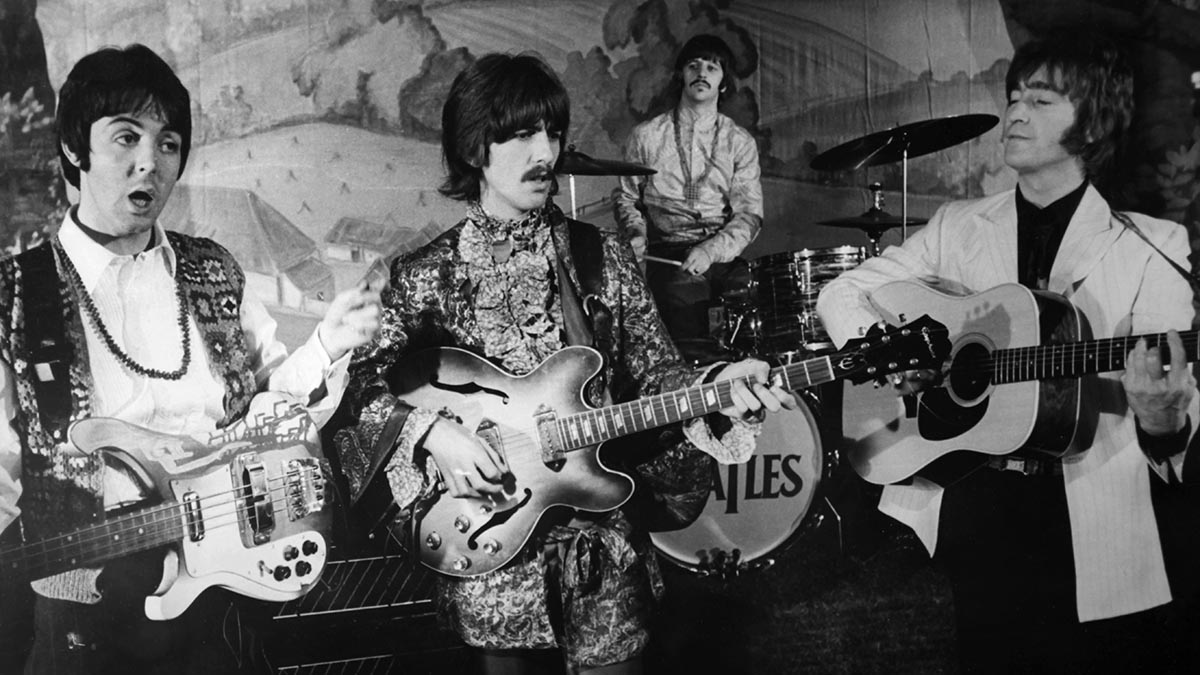
After attempts with traditional amps and fuzz boxes failed to satisfy Lennon, engineer Geoff Emerick conceived the idea of recording the guitars direct and overdriving the tube-powered REDD.47 line amplifier/mic preamp modules in the studio’s console. He finally accomplished the sound Lennon had in mind by cascading two REDD.47 units together, both with the gain set to excess levels.
Although a later promo video shows Lennon playing his Epiphone Casino (with the finish stripped off), Harrison on his 1957 “Lucy” Gibson Les Paul Standard and McCartney with his iconic Hofner 500/1 bass, Lennon’s Casino is likely the only guitar actually used on the studio recording. Instead, Harrison probably played his Gibson SG and McCartney used the Rickenbacker 4001S bass that had become his mainstay.
While My Guitar Gently Weeps – The Beatles (“The White Album”), 1968
Harrison
Guitar: Gibson J-200 acoustic
Lennon
Guitar: 1968 Fender Bass VI
Amp: 1966 Fender Deluxe Reverb with Oxford 12K5-6 12-inch speaker
McCartney
Guitar: 1964 Esquire
Amp: 1964 Fender Bassman (blonde) 6G6-B head, 2x12 cabinet with Jensen C12N, Oxford 12M6 or possibly Utah) speakers
Bass: 1966 Fender Jazz Bass
Amp: DI
Guitar: 1957 Gibson Les Paul Standard
Amp: 1966 Fender Deluxe Reverb with Oxford 12K5-6 12-inch speaker
Although George Harrison was the Beatles’ lead guitarist and had penned a song with “guitar” in its title, his guitar playing mostly took a backseat on the recording of While My Guitar Gently Weeps as he contentedly strummed acoustic rhythm on a Gibson J-200.
Granted, Harrison may have actually planned to play electric lead until he decided to invite Eric Clapton to play the song’s legendary solo, but since Harrison was Clapton’s good friend and he highly respected his playing it’s easy to understand his understated role.
The presence of Clapton in the studio motivated Lennon and McCartney to step up their game. McCartney contributed a solid electric rhythm guitar track that he played using his trusty Fender Esquire guitar/Fender Bassman amp rig, and Lennon doubled many of McCartney’s lines on a Fender Bass VI six-string bass (or possibly a Stratocaster or other electric) plugged into a Fender Deluxe Reverb.
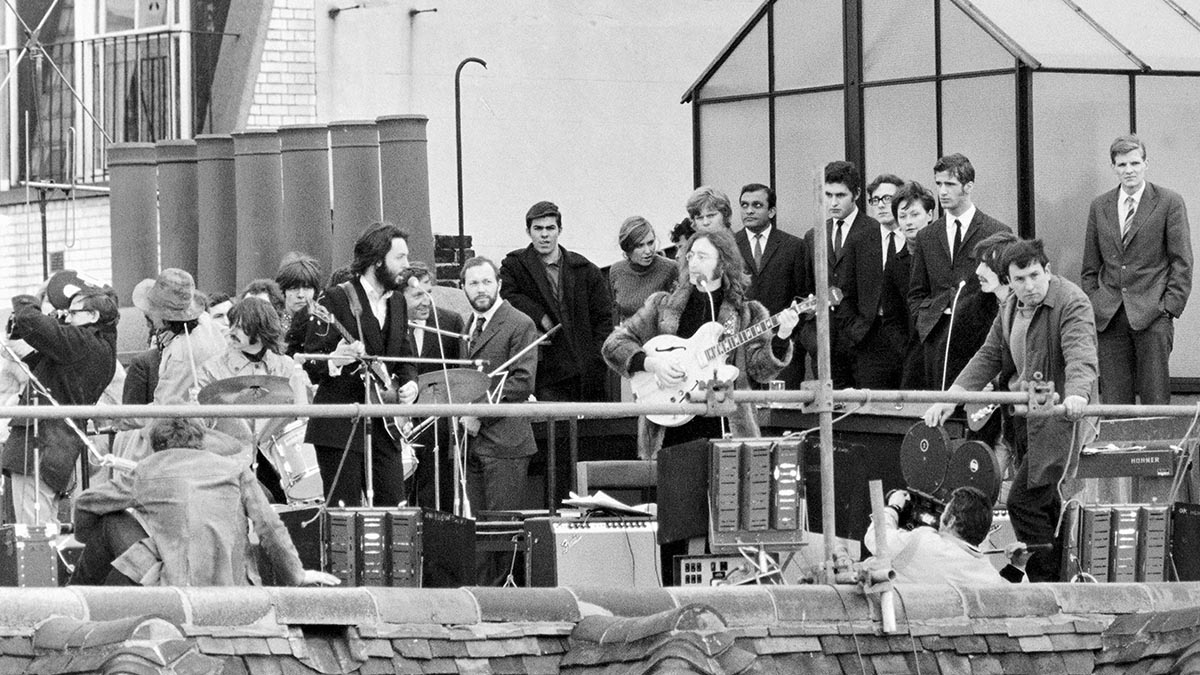
Clapton’s solo is rightfully the song’s main focus thanks to his soulful lines played on Harrison’s 1957 Gibson Les Paul Standard (nicknamed “Lucy”) through a Deluxe Reverb cranked almost all of the way up.
To make Clapton’s part sound more “Beatley,” his track was processed with ADT (artificial double tracking) during mixing. Producer Chris Thomas handled the task of manually adjusting varispeed during the ADT process, which gave the guitar its distinctive warbling texture.
Let It Be – Let It Be, 1970
Harrison
Guitar: 1957 Gibson Les Paul Standard (album)/1968 Fender Rosewood Telecaster (single)
Amp: 1966 Fender Deluxe Reverb with Oxford 12K5-6 12-inch speaker (album)/Leslie 147RV (single)
McCartney
Bass: 1963 Hofner 500/1
Amp: DI
When it comes to discussion of the guitar tone on Let It Be, the first question is whether it involves the single or album version, which are quite different from one another though each is equally impressive in its own right. The single was released first in March 1970, while a different version appeared on the Let It Be album released May 1970.
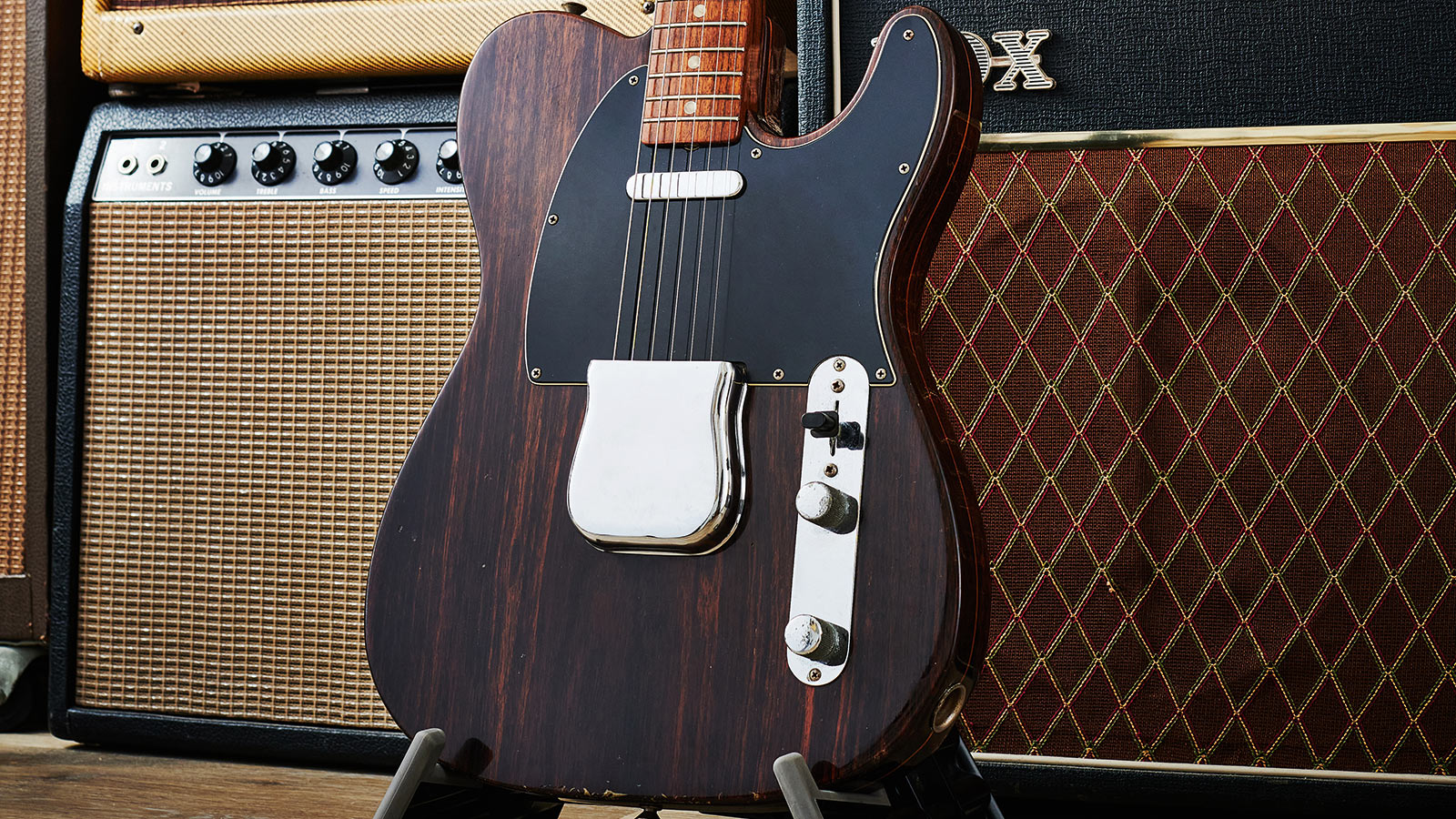
The single version’s solo was recorded in late January 1969. Although Harrison felt that the solo he played on a previous take was better, the consensus was that a later take featured a better overall performance even though Harrison’s guitar solo wasn’t quite as good. A few months later in late April, Harrison recorded a new solo, and a new mix of the song was done for the album.
For the single version, Harrison played the 1968 Fender Rosewood Telecaster that had become his favorite ax for the Let It Be sessions. He plugged it into a Leslie 147RV rotating speaker cabinet, which provided the warbling, thick, chewy textures.
His approach to the solo he recorded in April 1969 for the album version was more straightforward, employing his 1957 Gibson Les Paul Standard “Lucy” through an unknown amp cranked up to a good amount of overdrive. The midrange punch suggests he used a smaller amp, most likely a Fender Deluxe Reverb with a 12-inch speaker. There’s also the possibility Harrison played his Epiphone Casino E-230TDV instead of the Les Paul.
The End – Abbey Road, 1969
Harrison
Guitar: 1968 Fender Rosewood Telecaster
Amp: 1966 Fender Deluxe Reverb with Oxford 12K5-6 12-inch speaker
Effect: Dallas-Arbiter Fuzz Face
Lennon
Guitar: 1965 Epiphone Casino E-230TD
Amp: 1967 Vox Conqueror with two Celestion T1088 12-inch speakers
McCartney
Guitar: 1962 Epiphone Casino E-230TD
Amp: 1968 Fender Twin Reverb with two Oxford T126 12-inch speakers
Bass: Rickenbacker 4001S
Amp: DI
This song’s section where McCartney, Harrison and Lennon traded solos was one of the last truly happy moments that the three shared while they were still the Beatles. “I think in their minds they went back to their youth and all those great memories of working together as a band,” engineer Geoff Emerick later recalled. “Suddenly there was just this great vibe in the studio.”
Many guitar historians assume that each member of the guitar trio plugged into separate Fender Twin Reverb amps, similar to the setup seen in filmed Get Back/Let It Be footage. However, Emerick says that this was not the case: “I took great care to craft a different, distinctive sound for each Beatle, so it would be apparent to the listener that it was three individuals playing and not just one person taking an extended solo. They were each playing a different model guitar through a different type of amplifier, so it wasn’t all that difficult to achieve.”
Unfortunately, Emerick did not specify or recall exactly which guitars and amps they used. Most historians are pretty certain that Harrison played his Rosewood Tele and Lennon and McCartney played their Epiphone Casinos (maybe Emerick was confused by the contrast of the stripped finish on Lennon’s Casino and the original sunburst on McCartney’s Casino).
Going out on a limb to guess the amps, McCartney starts with a slightly overdriven tone that sounds like a Casino through a Fender Twin. Harrison’s tone has a sweet singing overdrive/distortion that sounds like a smaller amp (perhaps a Fender Deluxe Reverb) driven by a fuzz pedal, most likely one of the Dallas-Arbiter Fuzz Faces seen in the Get Back footage.
Lennon’s tone is characterized by distorted grit and an unusual honking midrange that’s unlike any of the Fender amps the Beatles used during that period. It’s possible that Lennon dusted off the Vox Conqueror last seen during the White Album sessions and used its Boost and MRB (Midrange Boost) functions.
Chris is the co-author of Eruption - Conversations with Eddie Van Halen. He is a 40-year music industry veteran who started at Boardwalk Entertainment (Joan Jett, Night Ranger) and Roland US before becoming a guitar journalist in 1991. He has interviewed more than 600 artists, written more than 1,400 product reviews and contributed to Jeff Beck’s Beck 01: Hot Rods and Rock & Roll and Eric Clapton’s Six String Stories.
















